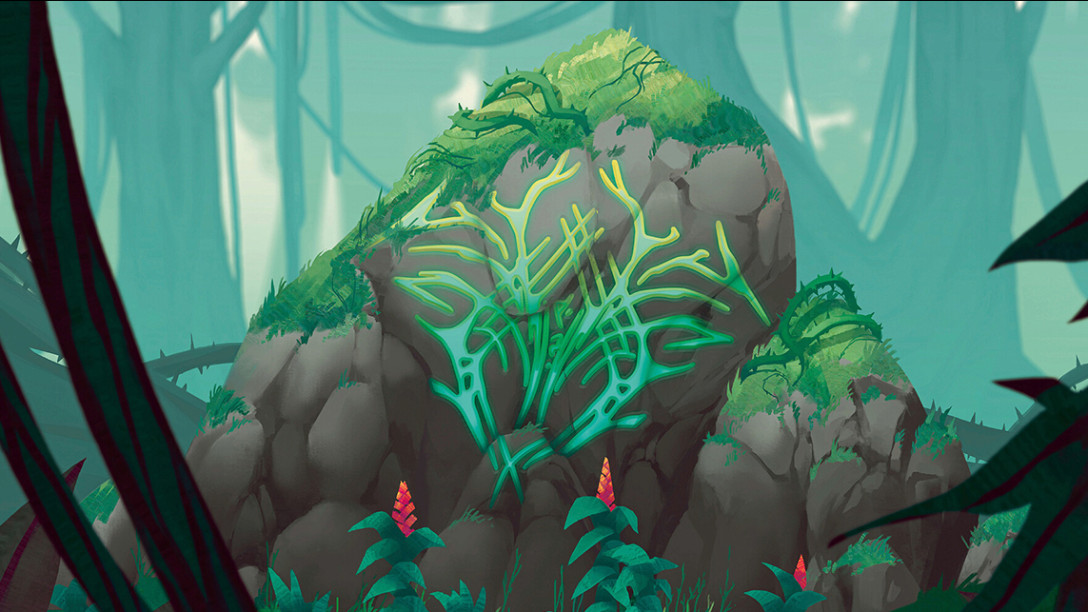After making a few comments on articles here that alluded to his deep understanding of the forces underlying Flesh and Blood gameplay, Max was invited to contribute a piece of his own that turned out to be a fascinating and extensive examination of the very core of the game.
Due to its length, we do not have an audio recording to accompany this piece.
The opponent is at one life. After an intense back-and-forth, the conclusion of the match is imminent. While we were able to pry a card out of their hand during our last attack, they preserved enough for a counterattack. We glance at our life total - it’s very low, but how bad can it be? We partially block their first two attacks, but some damage leaks through. We pray we can survive the turn with enough fuel in hand to mount an attack of our own.
Their last card hits the table and we feel our heart sink. We look at the cards left in our hand. We double check our life total - curse ourselves for the equipment block we made four turns earlier that we later realized was inefficient - but there is no way around it.
With a sigh we put our last two cards on the table to block. We survive this turn, but the game is over and our smirking opponent knows it. Even though we both have 4 cards in hand after we passed our turn, defeat is almost guaranteed - our opponent has the initiative and it’s almost certain that we will be forced into a defensive stance until the end of the game.
If there's a universal truth in this game, it might be this: The player who has the tempo in the end game - who can force blocks and command the initiative - will win the game.
But what are tempo and initiative? In this article, I want to explore these concepts - and along the way, talk about a related concept that comes up all the time when people talk about card games: value.
Defining Game Terms through Chess
I believe that tempo and value in Flesh and Blood are intertwined in interesting ways - and are not that easy to pin down. For this reason, I would like to begin our exploration on firm ground and look at a game where these terms are well defined: chess.
Chess is played on a board where a number of pieces are initially placed in a certain formation. Each player has control over half of these pieces and gets to move one piece per turn. If they move onto a square where an opposing piece is positioned, that piece is “captured” and removed from the game [11].
Just like the basic rules, the ultimate objective is simple: We need to capture the opposing king. Nonetheless, the game has an immense strategic depth that has been fascinating players for centuries. Over time, a lot of theory has been developed around the game, which has then also been applied to other games that came after. We will use this knowledge as a basis for our analysis and will begin by examining some of the concepts that were developed for chess.
Initiative
If a player has the initiative, they can “make threats that cannot be ignored, thus putting the opponent in the position of having to spend turns responding to threats rather than creating new threats themselves” [8].
This definition also applies quite nicely to Flesh and Blood, and we will use it from now on. This concept is closely linked to the notion of “forcing blocks”, where the defending player has no choice but to commit some (or all) of their cards to defending.
Value
Value in chess describes the different pieces on the board. Depending on their movement capabilities, they are worth more or less - lowly pawns that can only move forward and only one field at a time are the least valuable, while our “go-get-it-done-piece” - the mighty queen - can move as far as she wants in any direction and is the most valuable [7].
Some pieces - and some cards - are simply more valuable than others.
Tempo
Tempo, on the other hand, is a little more complex. Essentially, it refers to the amount of moves a player needs to place a piece in a desirable position (where using less moves is considered higher tempo).
If a player has a tempo advantage, they are usually presenting a more threatening attack by having more pieces in strong offensive positions [12].
"If you come at the King, you best not miss."
While tempo and value are technically independent (meaning a single move can gain or lose tempo and value at the same time), they are often at odds with one another.
A classic example is the bishop sacrifice: Here, a player trades a higher value piece (the bishop) for a lower value piece (a pawn) in order to clear a path for an attack on the opposing king.
If the subsequent attack is defended, the attacking player is now at a disadvantage, as they sacrificed value to temporarily gain the initiative. However, such a tempo play can sometimes be converted back into value if the defending player was forced into making a tempo play themselves in order to stop the attack.
From Tabletop to TCG
Before moving on to our main subject, let’s briefly look at another game, one that is in many ways quite similar to Flesh and Blood: Magic: the Gathering.
Just like chess, Magic: the Gathering has a board where most of the game takes place. However, just like Flesh and Blood, it is a card game where the game pieces are not on the board from the beginning, but enter play over the course of the game, often requiring the player to pay some sort of resource cost.
Unlike Flesh and Blood, the cards that are played out during a game of M:TG usually have a lasting effect: either they stay in play until the opponent removes them, or they remove some of the opponent’s presence on the board.
The ultimate goal of the game is to reduce your opponent’s life total to zero, and this usually happens by seizing control of the board and using this advantage to go on the attack.
Resources that pay for cards are built up slowly over time, which means that there is a decision to be made to quickly play out multiple cheap cards, or play out more expensive cards over multiple turns [10].
Card Advantage
The last piece of the puzzle that we need to fully understand tempo and value in Magic: the Gathering is card advantage [2]. The idea, in it’s essence, is quite simple: besides the life total, cards are the main resource of the game. Card advantage comes from using our cards more effectively than our opponent. Drawing extra cards, removing multiple of our opponent’s cards from the board by spending just one card, or advancing the board state without spending cards all create card advantage.
Tempo
Just like in chess, playing for tempo in Magic: the Gathering means putting our game pieces into strong offensive positions in order to threaten our opponent (except we threaten their life total instead of their king) [5]. Leveraging tempo to our advantage means to either overwhelm our opponent and kill them before they get to use their resources, or run them out of resources because they are forced to use them inefficiently to answer our threats.
In Magic: the Gathering, many cards will exclusively gain value (Night’s Whisper) or exclusively gain tempo (Vapor Snag) when played out. Some cards will provide both value and tempo (Siege Rhino).
Value
Value is again understood in the context of the game pieces (cards in this case). Each individual card will have a certain value when played out, and it can be measured in terms of card advantage - if we play out less or draw more cards than our opponent, they will run out of them before we do. Running our opponent out of cards (and thus, resources) is another way to go about winning a game of Magic: the Gathering.
Deck Archetypes
A unique feature of card games such as Magic: the Gathering and Flesh and Blood is that the players can choose the game pieces (i.e. cards) they bring to the table and thus decide whether they want to attempt to win the game with tempo or value before the game even begins.
If one is choosing to go the tempo route, they need to gain control of the board early on, which means that they are going to play cheaper cards. This also has the added benefit that they will be able to start playing multiple cards in a single turn earlier on, providing them with additional gains in tempo. However, cheaper cards are usually lower in value, which means that a player choosing to employ a slower strategy will usually end up with card advantage as the game goes on.
We call decks that are looking to create a tempo advantage and gaining initiative early “aggro”, with “control” decks on the other side of the spectrum. Additionally, “midrange” decks are something in between - slower than aggro, but faster than control [9].
Conventional wisdom has it that being a little slower than our opponent is an advantage, as we will be able to defend against their early pressure and then beat them with card advantage. On the other hand, being a lot faster than our opponent is said to often be too much for them to deal with [1].
This idea of a triangle of strategies has been in the minds of players for a long time, and naturally they tried to apply it to Flesh and Blood. However, unlike in Magic: the Gathering, the distinction is not as clear, which has a lot to do with tempo and value working differently - and sometimes counterintuitively - in Flesh and Blood.
Finally, Flesh and Blood
For an article about Flesh and Blood, we’ve just spent a lot of time talking about different games; but I believe it is useful to review where existing assumptions are coming from before we try to analyze where the differences lie.
The first thing we have to understand about Flesh and Blood is that, because there are only a few ways to add persisting game pieces to the board, we have to consider tempo and value on the basis of a turn cycle, with frequent and drastic shifts from one cycle to the next.
Tempo
Let’s take a close look at the beginning of a game of Flesh and Blood.
Alice - the person going first - simply added a card to their arsenal and passed the turn. Now, their opponent Bob has a full grip of 4 cards to go on the attack.
Intuitively, we are inclined to say that Bob has the tempo advantage, but what exactly makes this assertion so natural? We understand that having more cards will create a stronger attack, but that the amount of cards we have available will vary on a turn-by-turn basis. We also know that the amount of cards we have available at the start of our turn is threatened by the amount of cards our opponent attacked us with on their turn.
Just like in the other games that we discussed, having a tempo advantage means putting ourselves into a strong offensive position. As such, the most offensive position that we can be in is if we have a full grip of cards that was not challenged at all by our opponent on their turn. Conversely, the most defensive position has us committing all of our cards to blocking our opponent's attack without sending any threat back at them on our turn.
With this, we can now define tempo in Flesh and Blood:
Tempo is the number of cards that we threaten our opponent with minus the number of cards our opponent threatens us with.
Intuitively, a good moment to take this measure is at the start of each turn. To illustrate this, let’s analyze the hypothetical game that we just started to describe:
On turn zero, Alice placed a card into the arsenal and passed the turn. At the start of turn one, Bob now has four cards available and was threatened with zero cards by their opponent.
We will always take the perspective of the active player (the one just starting their turn). A positive value means they are ahead, and a negative that they are behind on tempo.
Cards available: 4
Cards threatened with: 0
Tempo: +4
Bob has a distinct tempo advantage.
On turn one, Bob attacks with three cards and places the last card into the arsenal. Alice blocks with one card.
At the start of turn two, Alice has four cards available (three in hand, one in arsenal) and was threatened with three cards.
Cards available: 4
Cards threatened with: 3
Tempo: +1
Alice has a slight advantage.
We can see that over the course of turn one, the tempo shifted from being in favor of Bob to being in favor of Alice. However, it came at a price: since Alice blocked a three card attack with only one card, they paid two cards' worth of life points for this shift.
On turn two, Alice now attacks with four cards and Bob blocks with three.
The situation at the start of turn three:
Cards available: 2
Cards threatened with: 4
Tempo: -2
Alice is still at a tempo advantage (remember we are taking Bob's perspective at this moment).
On turn three, Bob attacks with two cards and Alice blocks with two cards.
At the start of turn four:
Cards available: 2
Cards threatened with: 2
Tempo: 0
Completely even.
In this manner, we can keep analyzing each turn of the game and track the shifts in tempo.
Astute readers may have noticed that I assumed Alice just places a card into their arsenal on turn zero instead of attacking. Wouldn't that turn zero attack mess with the entire calculation? The solution here is simple: since tempo is about the interplay between threatening the life total and the hand cards, turn zero presents an exception to the rule: Bob will draw up to their intellect at the beginning of their first turn, so their hand cards are not actually being threatened by an attack on turn zero. As such, we will always assume that Bob had been threatened by zero cards when we make the tempo calculation at the start of turn one. For this reason it also does not make much sense to attempt to calculate tempo on turn zero. Arguably, it would be 0 (0−0), but that doesn’t really tell us anything interesting.
Let’s take a step back from the minutia of calculating tempo and remember the assertion that we made at the start of the article:
The player who has the tempo in the end game - who can force blocks and command the initiative - will win the game.
Now we might conclude that, if tempo is so important, we should aim to have it at all times. In fact, it’s easy to see the mistake that our hypothetical players Alice and Bob made: They used their cards to block with and thus gave up tempo!
However, if we have played Flesh and Blood for some length of time, somewhere within our repressed memories we are likely to find a game that played out something like this:
Turn after turn, we threw our entire hand at the Guardian, who calmly blocked with most of their hand and on their turn respond with a simple “hammer for four”. We held the tempo advantage the entire time, but after a couple of turns we glanced at our life totals and noticed that we were still at parity.
Value
To answer this mystery, we first have to understand how value works in Flesh and Blood.
If you're coming over from Magic: the Gathering, you might think about creating value through card advantage, but this is a lot more difficult to achieve in Flesh and Blood. While drawing extra cards is still a good thing, it only really matters if we can make use of these cards in the same turn that we draw them. This is due to the fact that we always draw up to our intellect as per the rules of the game, so not spending or arsenal-ing a card is effectively card disadvantage.

If we play a Snatch as our last card of the turn, without go again, while having a card in our arsenal, the on-hit trigger is irrelevant because we would have drawn that card at the end of the turn anyway!
However, there is another form of card advantage in Flesh and Blood, one that has the same aim as control decks in Magic: the Gathering, and that's running your opponent out of resources entirely [3].
One of the advantages of pitching multiple cards to play big attacks - rather than slamming a bunch of go again attacks on the table - is that we put more of our hand back into our deck at the end of the turn.
Similarly, a weapon that is more powerful but needs more resources to be activated will, in the long run, force more blocks from our opponent than a low cost, low damage weapon.
If the game does not end from one person overwhelming the other, the ultimate decider will be who runs out of cards first.
Card advantage is measured in the amount of cards that you need to spend (i.e. that end up in the discard or banish pile) in order to play out your turns.
It should be noted here that just blocking with everything is not going to win this kind of card advantage game, unless our opponent is actively burning cards from their deck (e.g. Chane or Dash). Even the most aggressive of decks will still be doing some pitching, so a purely defensive deck will lose equal or more cards on blocking.
Most games will however be decided on another axis:
The easiest way to calculate this is to sum the amount of damage we threatened when we were attacking and the amount of damage we prevented by blocking. In order to evaluate how well our turn went, we need a baseline to compare it to.
Cards in Flesh and Blood are designed in a way that indicates that a point of attack is equally as valuable as a point of block or a resource gained by pitching. For our baseline, we will assume that we should be able to get around three points of value from an average card. This estimate is based on the assumption that we will generally choose to attack and block with cards that attack or block for three or more per card spent, as well as aim to pitch blue cards to gain the most amount of resources.
This three-points-per-card estimate is actually quite a conservative one, as we will often be able to realize more value if we play our hands right - in particular, if we use our cards offensively. As such, any play that realizes less than three value per card should be considered “below rate”.
If we come from Magic: the Gathering, we might assume that high cost cards are high in value and low cost cards are low in value. However, if we look at a card like Thunder Quake (red), we can see that we get ten points of value for the cost of three cards, which is not great if we com pare it to the twelve points generated by Ronin Renegade, Searing Emberblade, Phoenix Flame, Lava Burst.

Assume both lines played from a 3-card hand - the latter harnessing the power of Searing Emberblade and Fai's ability to pull a Phoenix Flame from banished.

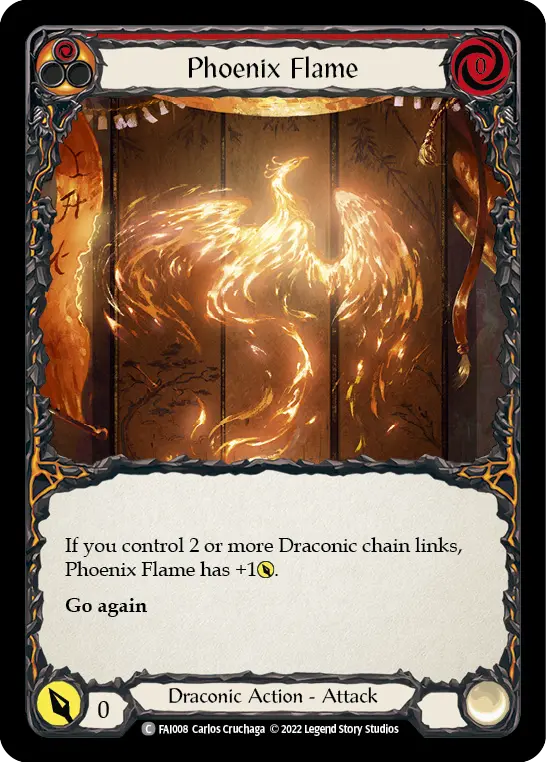
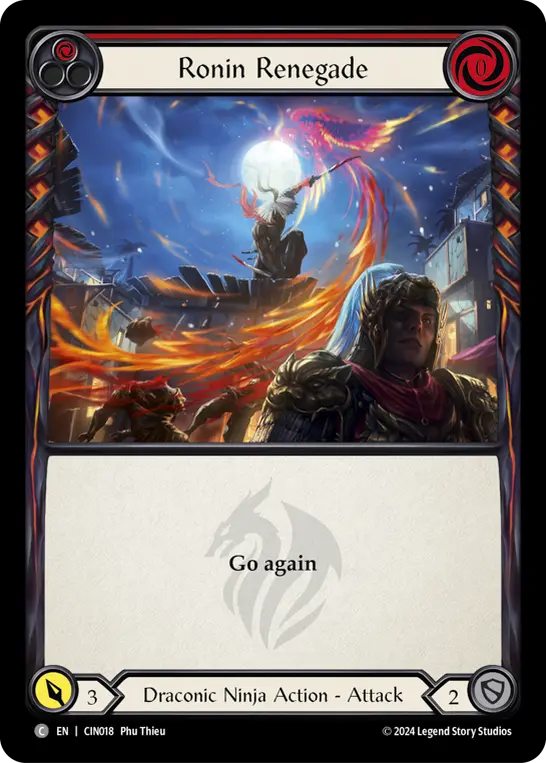
Two points might not seem that much at first glance, but we are talking about a 20% increase in damage! If this happens consistently over the course of the game, it will add up very quickly and be converted into a massive life lead.
An important thing to note here is that the highest value card in this example was Lava Burst, as it represents five points of damage - two more than we would expect from an average card and exactly the two extra damage we get as an advantage over playing a single big attack like Thunder Quake.
This observation might also lead to us noticing that many cards perform very differently depending on whether they are played offensively or defensively. To give an example, Blaze Headlong is quite obviously an offensive card: if we block with it, we only get two points of value from it, while attacking with it yields four.
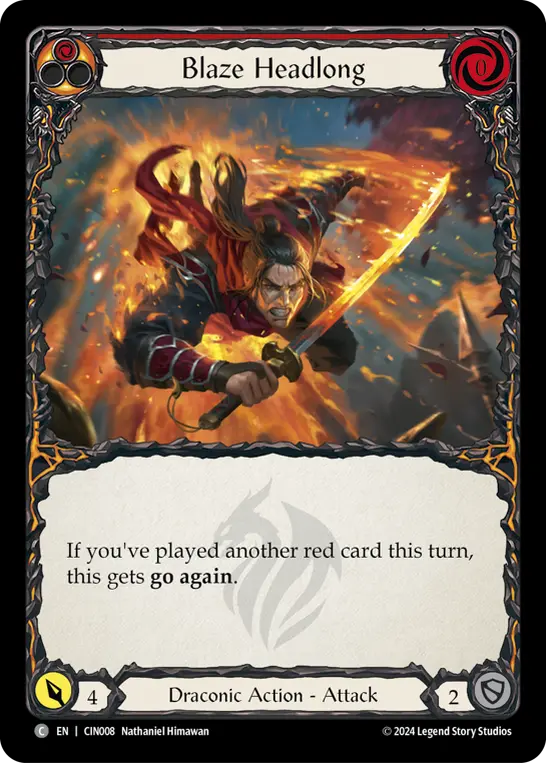
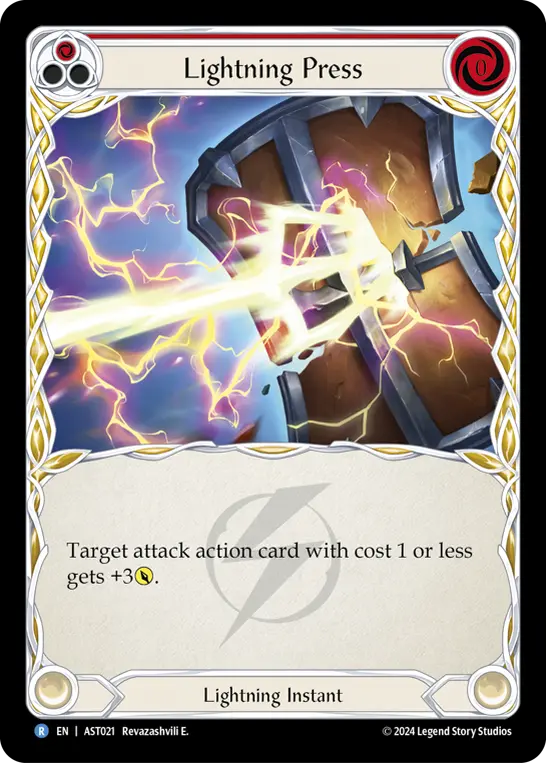
An even more extreme example of an offensive card is Lightning Press, which can’t be used defensively at all, while presenting an on-rate value of three with the added bonus of being an instant.
Soulbead Strike (blue), on the other hand, is better on defense, as there it will provide a perfectly reasonable three, as opposed to just two on offense. Another example would be Autumn’s Touch (blue), which also only yields two on offense: we attack for five, but we also need to spend three resources (this can also be thought of as needing to pitch at least one card to play it, which would mean we would expect at least six points of value to be on rate).
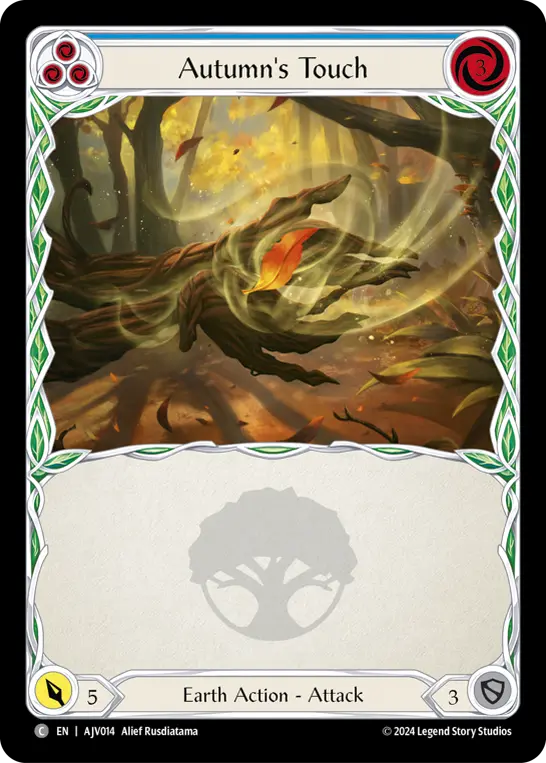

The clearest examples are, of course, cards such as Sink Below (red) and Oasis Respite (red) which will give us 4-5 value on defense and at best one pitch on offense.


Tempo Influences Value
Now these are all relatively basic examples, but if we look at other cards, we start to suspect that there is a connection between tempo and value in Flesh and Blood.
In fact, this was already nicely illustrated in our previous example involving Lava Burst: the value that this card represents depends to a large extend on whether we are playing a small or a big turn. On its own, it provides a measly two points of value; but in conjunction with other cards played on a long chain link, that value jumps up to five - clearly way above rate!

Another, more complex example is Art of War. Played off of a five card hand (4 in hand, 1 in arsenal), it can end up representing upwards of five points of damage for the cost of one resource, which is an absurdly high rate. The value of a card can be expressed as damage, block, or resources (three on average), meaning that we can even add two points of value to any damage the Art of War provides to our attacks (provided we were able to pitch a blue card to play it and made good use of the remaining resources).
In this example, we might get up to 5 damage + 2 resources = 7 value. Playing it defensively, on the other hand, is absolutely miserable, as it regularly converts to just two value (we end up spending a card to buff two of our blocking cards by +1).
In the same vein, playing it even with a three card hand (still a comparatively large turn) might not allow us to even get above three value (2 resources + 1 attack buff ).
As we can see, it not only matters whether we play an individual card offensively or defensively, but with how many other cards we pair it with! This is where tempo comes in: if we can win the tempo, our hand size is under less threat, which lets us keep larger hands and make better use of our aggressive cards.
This kind of pattern can spiral into a situation where we keep making the fight for the tempo very costly for the opponent, because we can generate back to-back high value turns. Forcing our opponent into a completely defensive stance means that they cannot fire back at all and will eventually fall to our flurry of blows. This is the situation described at the beginning of the article, and is comparable to a boxer being “on the ropes” - trapped in the corner of the ring where all they can do is to put their arms up while their opponent pummels them until the round ends or they get knocked out.
However, this does not mean that all is lost once someone gets cornered. Many over-aggressive athletes ended up getting caught by a well-timed counter left hook, and some decks play better on the defense than others...
Deck Archetypes
If our deck is full of cards like Blaze Headlong (red), Lava Burst, and Art of War, most hands that we draw will need to be played out as a big turn (i.e. without blocking much, if at all) in order to maximize value. Conversely, decks that are full of cards like Autumn’s Touch (blue) and Sink Below (red) will regularly draw hands that generate more value when most or even all cards are used to block.
This now explains the mystery that we encountered before: in order to play at maximum efficiency, the player piloting an aggressive deck would not block any of the attacks their Guardian opponent presented, but in the meantime their opponent would also play their deck at maximum efficiency by blocking a lot and making small counterattacks here or there.
Playing for tempo means making the most threatening attack that we can possibly make. This will increase tempo both by definition and by potentially coaxing our opponent into blocking. However, playing for maximum tempo is often not the same as playing for maximum value!
Even though one player has the tempo the entire time, both players are playing in a way that maximizes the value their respective decks can generate. Therefore, it is not all that surprising that, when the dust settles, both players will have lost a similar amount of life points - while winning the tempo is generally advantageous, playing for maximum value might mean sacrificing some amount of it.
What kind of hands we draw on average will depend on the cards that we put into our deck, which leads us to the following observation: depending on our deck, we are generally more or less interested in fighting for the tempo advantage. With this understanding, we can now even draw the comparison to the three major deck archetypes of Magic: the Gathering:
"Aggro” decks can make the most out of a tempo advantage and will commit strongly to gaining and keeping it. They ideally want to attack with 4-5 cards every turn, forcing their opponent into the corner.
“Control” decks, on the other hand, want to block with most or all of their hand, often giving up the tempo because they are less equipped to make use of it. They want to stay safe, roll with the punches, and chip in with jabs.
“Midrange” decks will again fall somewhere in between, and have the most hand-to-hand variability in terms of whether they want to fight for the tempo at any given time. They will bide their time, stay defensively responsible, but are willing to take a punch on the nose in order to land a booming counter.



Initiative
This is all well and good, but why should we care about any of this? Let’s get back to the beginning one last time:
The player who has the tempo in the end game - who can force blocks and command the initiative - will win the game.
In order to create a threat that is big enough to win the tempo and snowball into an initiative chain, we usually need to keep a high number of cards in hand. Unless we already have the tempo advantage, this means that we will need a high enough life total in order to afford taking the attack our opponent is presenting, such that we are not forced into blocking ourselves. But who will be the player that has this life lead and can afford to make a big tempo play towards the end of the game?
While recognizing the right spot to try and make this kind of play (subsequently referred to as “pivoting”) is an important part of Flesh and Blood, it will usually come down to who was able to create more value over the course of the game. This is why maximizing value should be our primary goal!
Controlling the Tempo
Tempo plays a big part in our pursuit of maximizing value, since being under pressure to block might force us into getting less than we could out of each hand. At the same time, putting this pressure on our opponent might put them into a position of having to take sub-optimal lines as well.
Having the tempo advantage means that we relieve some pressure while simultaneously putting more pressure on our opponent. While everyone would like their opponent to just always block with all their cards and never attack back, this is not realistic in an actual game. Each players' life total is a resource that can be spent to fight for tempo, and even the most inexperienced player understands that they have to do so from time to time.
There will be a fight for the tempo advantage, but we might play a deck that can afford or even wants to give up tempo in order to exploit our opponent’s tendency to fight for it at all costs, leaving them open for chip damage.
After all, for most of the duration of the game we don’t care who has the tempo as long as we are winning the battle over the life totals. The important thing that we concluded is this: some decks play optimally off of a large tempo advantage, while others are running at optimum efficiency at an even tempo or even at a tempo disadvantage.
Either way, our interests are likely at odds with our opponent's, which is why we should spend some time pondering the following questions: What tempo is ideal for me? What tempo is ideal for my opponent? Who does it hurt more to play at a sub-optimal tempo, me or my opponent? Are there ways that I can influence the game so we are playing at my optimal tempo? Deciding the optimal tempo for our own deck and judging what our opponent is trying to do will be dependent on the decks that are going up against each other.
When it comes to influencing tempo, however, there is a set pattern that comes to our attention: giving up tempo is generally “free of charge”, while fighting for tempo usually comes at the price of life points.
If we decide to block our opponent's attacks, arsenal a card, or play out a card onto the board rather than attacking with it, we are not giving up life points for it. In fact, deciding to block our opponents attack is the most common form of conceding tempo, and here we are actively protecting our life total; one could say that we are converting tempo into life points or resources that we will have available in a future turn.
Fighting for tempo, on the other hand, almost always means that we have to eschew blocking our opponents attacks; we are converting life points into tempo.
With this general principle in mind, let’s look at some specific examples of plays that either give up or increase tempo.
Setting Up
If we remember how things work in Magic: the Gathering, we might assume that developing game pieces onto the board is a way to influence tempo. And indeed, if we spend our resources (action point, pitch) to play out a card like Energy Potion or Genesis, we are giving up tempo for this turn cycle. Rather than fighting for the tempo advantage by attacking, we instead store some value (in the form of a card) on the board for later use. Similar to the blocking example, we converted tempo into something else — in this case resources (i.e. value).


However, this is contrary to what we would expect when coming from Magic: the Gathering, where developing cards onto the board is a way to fight for tempo. Giving our opponent the tempo advantage for “free” can be advantageous if their deck (and more importantly, their current hand) is set up to play most efficiently when they are even or slightly behind in tempo.
Let’s think back at the example with our Guardian opponent swinging the hammer every turn - oftentimes this is the best attack even a full hand from that kind of deck can produce.
We can exploit this kind of low tempo playstyle by alternating “setup” turns where we convert tempo into cards that are stored on the board (most often in the arsenal) and big turns where we use these extra resources to go over the top of their defenses.
Forcing Initiative
But what about fighting for tempo? While keeping large hands to attack with is an attempt to gain the tempo by definition, the key to forcing a tempo advantage is initiative. We need to create threats that our opponent has to respect. In this way we can put our opponent in a double bind where they will end up giving up tempo, regardless of whether they choose to block or not.



Another way to create initiative is to threaten to generate unreasonable amounts of value if our attacks are not respected. Naturally, these kind of effects will be most effective against “aggro” decks that are generally more dependent on having the tempo advantage.
Tempo Plays
We can also draw another parallel to the concept of tempo plays that we touched on earlier. Just like before, a tempo play is a move that sacrifices value for tempo.
In Flesh and Blood, many of the cards that force initiative are actually examples of this - a Command and Conquer against a set arsenal will almost certainly take some cards from your opponent's attack away, but we are spending two cards for six points of value, which is somewhat less than what we’d want from this kind of attack. Similarly, a Crippling Crush without a Surge token represents eleven value for four cards - way below rate (compare this to the around 16 damage a good “aggro” deck regularly generates with four cards).


While we might play a Pummel on the Command and Conquer or dominate the Crippling Crush to get both value and tempo out of the deal, a lot of the natural power of this type of card comes from creating value indirectly by lowering our opponents tempo below their comfort zone.
We should also keep in mind that chaining attacks with initiative could snowball us into this highly desired endgame position where we can maintain our initiative simply by presenting damage, as our opponent is now low enough to always be forced into blocks.
As a side note, if our plan is to keep the initiative after we make a tempo play, taking some extra damage to set up another power card in our arsenal is probably a good idea. Failing to recognize this is a mistake that even advanced players sometimes make; playing a Pummel on a Spinal Crush feels amazing, but if your opponent already blocked with three cards, is there really the need for it? They are likely to just arsenal their last card or come back with a weak turn, which means that we are almost guaranteed to be able to fire off the Pummel and thus maintain the tempo advantage on the next turn.
Another example of a tempo play is to take advantage of a life lead accrued through a strong early- and mid-game by purposely keeping extra cards in hand that would have been slightly more effective when played defensively because we want to push our opponent as quickly as possible to our winning end-game.
However, just as we saw in the chess example where our bishop died in vain, this kind of move can backfire. If our Crippling Crush is defended by an Unmovable from arsenal, we were unable to break our opponent's tempo enough to prevent their counterattack and they just gained a massive value advantage.
Pivoting
While blocking with our entire hand will also give up a resource (the then-unused action point that we get on each of our turns), sometimes it’s simply the right thing to do. In order to be the person that is the first to gain the initiative and force our opponent into perpetual defense, we might need to make a high tempo, high value play.
This usually means setting up a key card in arsenal or even develop some lasting cards like Energy Potion on the board. We then bide our time playing defensively, waiting for the right moment to strike.
This is called “pivoting”, and examples of it are using full hands to present massive damage with Art of War, Channel Mount Heroic, or dominating and successfully activating the “Crush” effect of Crippling Crush.


Since, by definition, pivoting refers to game states where our opponent has the tempo advantage prior to our play, we need to be able to absorb our opponent's attack with a high life total and/or equipment, and thus prevent them from gaining the initiative.
If our pivot is successful, we not only created a high value play, we often also gained the initiative ourselves. Depending on the game state, this could be the beginning of the end for the opponent, as we might be able to maintain the initiative and thus keep an overwhelming tempo advantage until we emerge victorious.
Closing Thoughts
There was a lot to cover - and we didn’t even get to how Wizards and Illusionists play with tempo! As a last little idea, I would like to leave you with this question: can we assign a value to the tempo advantage that Bob has on turn 1? Just like a cheeky reading of E-Strike might lead us to conclude that Legend Story Studios believes that drawing a random card and go again are equally valuable and that said value is 2, we can turn to the rules of the game to answer our question.
Bob, as the player going second, will start with the tempo advantage, but Alice gets to set an arsenal. This means that the tempo advantage should be worth about as much as setting an arsenal - something we could value at about 3 points.
Whether you are one of the players that regularly competes at Pro Tours, a complete beginner, or somewhere in between, I hope you found this article useful and were able to gain a deeper understanding of the concepts of initiative, tempo, value, as well as related concepts such as card advantage and pivoting, and how they are connected to each other in the context of Flesh and Blood.



